One of the most unique aspects of Newtonium Engine is its dice rolling mechanic, based (loosely) on the card game, Cribbage.
As you read on you will no doubt be intrigued and possibly even slightly overwhelmed by its seeming complexity. However, in playtest I have found that people quickly pick up the system and appreciate it for both the flavour it gives the game and the tactical decisions it allows. It may seem complex at first, but it won't be long before you're rolling with it and seeing what it can do to enhance your game.
Since discovering Qin: the Warring States back in the noughties I have become hooked on roleplaying games having an interesting dice rolling mechanic that captures something about the feel of the game. With historical games, like Qin itself, Newtonium Engine, and even my older game, Midgard, I especially like how they give you a bit of an idea of the culture that you will be asked to build your characters within.
Inspiration
To some extent, the Cribbage Dice mechanic was the original inspiration for Newtonium Engine. I'd been toying with the idea of some sort of clock-punk game for a while, largely as a fantasy setting rather than a historical one, but had never really put anything solid down on paper. Then my parents introduced me to the game of cribbage, and I was struck by its scoring system and how interesting it might be to have a dice mechanic based on it. I put some numbers down on paper and did some rudimentary probability calculations in a spreadsheet, and was pleased with the result.
I then looked into the game's history and discovered it was invented in the 17th century and had become extremely popular by the 18th. This was the moment when two completely unrelated ideas cam together in a flash. The key period for my clock-punk game would be the 18th Century also - where we'd not yet mastered steam power, but were at the height of our mastery of clockwork technologies. I can still remember the phone call where I outlined the idea to Nigel, talked him through the dice mechanic and he told me I was on to a winner.
So what is the cribbage dice system? How does it work?
In the game of cribbage, all player pass cards to the dealer, who sets them aside as his "Crib". This allows the dealer to score additional points at the end of the round. It is this crib that we simulate with the cribbage dice.
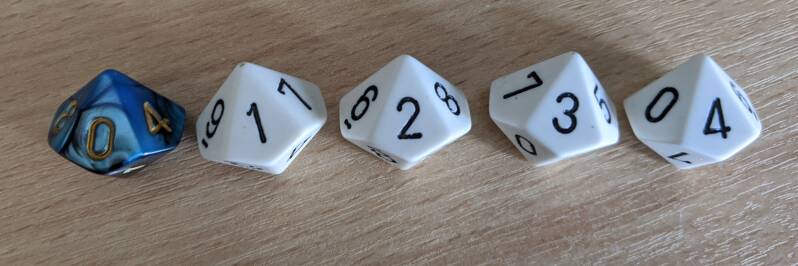
The dealer's crib in cribbage is always 4 cards, hence your crib is always 4 dice, using 10-sided dice (d10s) to represent the cards. It's best to find 4 dice of the same colour to represent your crib. In addition, there is a fifth dice, known as your Virtue Dice (your main attributes/ability scores in the game are called virtues). Whilst the virtue dice functions on its own, merely adding the value rolled to the result, the crib dice are used to score (or "peg") extra points and additional effects (which we will talk about later).
- If you have at least one 10 in your pool this is called "One for his Knob" and is worth +1 to the result.
- If you have a pair of dice showing the same value, you score +2 to the result.
- If you have a pair of dice whose total adds up to fifteen, you also score +2 to the result
- Where you have 3 or 4 dice showing the same result, or multiple combinations of two dice that add up to fifteen, you score each combination separately, making 3 of a kind worth +6 and 4 of a kind worth +12!
- If you have 3 dice in your crib that have consecutive values (a 3-dice run), it scores +8, whereas a 4-dice run scores +10.
- Lets have a look at some examples:
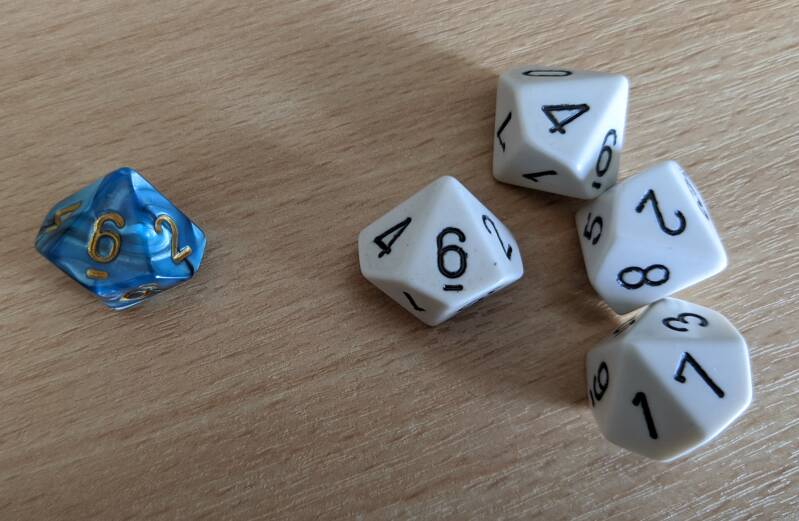
There is nothing that scores extra in this crib, so the roll of 6 on the virtue dice is the final result.
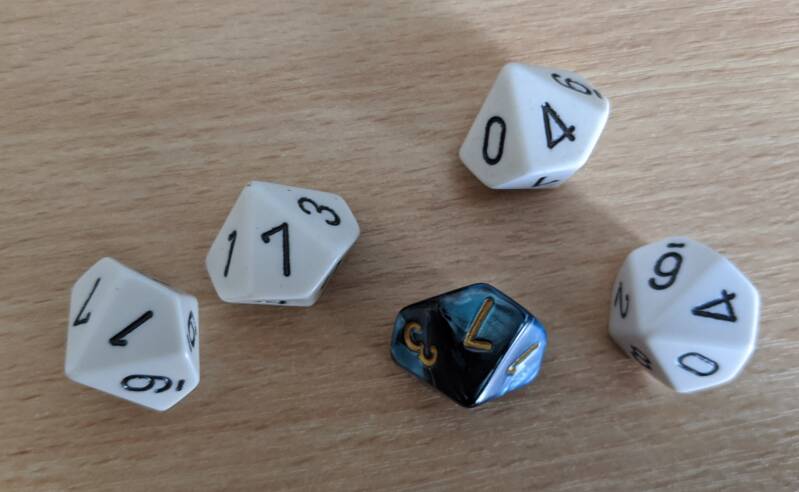
There is a pair of 4s on this roll (the 7 on the virtue dice does not count as part of the crib and so doesn't pair with the other 7). The result of the roll is 9 - 7 (virtue dice) + 2 (one pair)
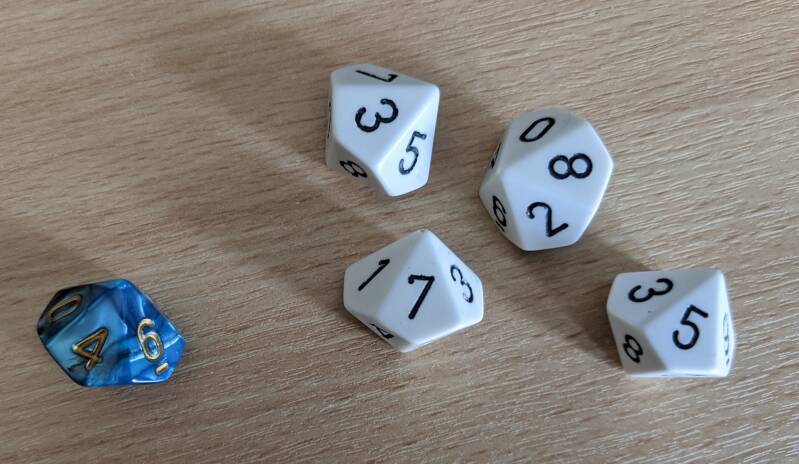
The 8 and 7 in the crib add up to 15. With the 4 on the virtue dice, this comes to a result of 6 on the roll.

In addition to the 10 and the 5 on the roll (10s are printed as zeros on many d10s) adding up to 15, the 10 itself pegs "one for his knob", adding a total of +3 to the virtue dice of 8 for a result of 11.

With three sixes you can form a total of three different pairs from this crib. Adding this as +6 to the 5 on the virtue dice gives you a result of 11.
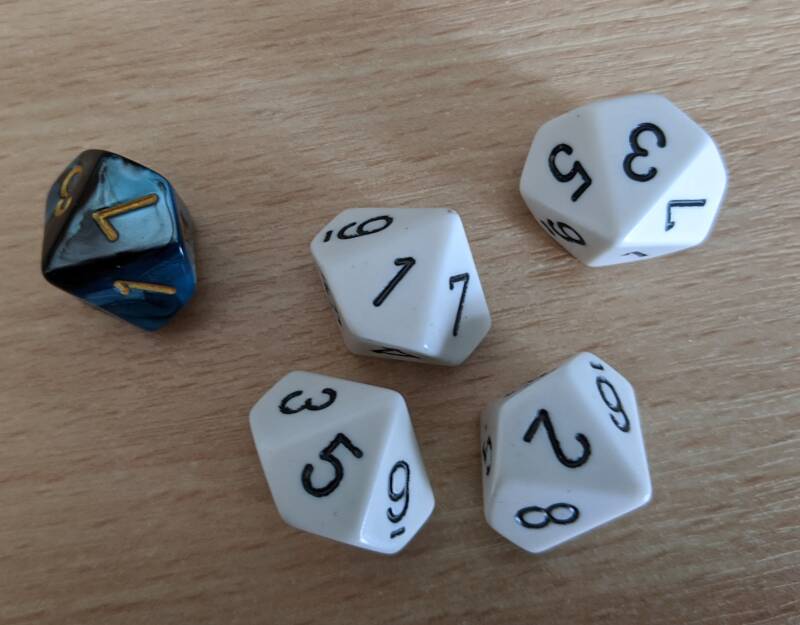
The 1, 2 and 3 in this crib form a 3-dice run, which is worth +8 to the result. Add this to the 7 on the virtue dice and your total is 15.
Triggered Effects
Not only are the dice in your crib improving the overall result of the dice roll, but they are also triggering different effects, depending on the roll:
- Pairs: the statistically most likely result, pairs trigger the most minor effects, such as a small bonus to your next dice roll or a small penalty to your opponent's next roll with a specific skill specialisation.
- Fifteens: about half as likely as a pair, on a fifteen you are gain the ability to provide your allies with a small bonus, penalise a wider range of your opponent's rolls, or maybe a sidestep around or push your enemy about on an attack.
- Runs: Runs are the least likely result, and four-dice runs are especially rare. As such they have the most significant effects, such as providing you with a bonus to your passive defence or perception scores, or dealing extra damage or knocking your opponent down in combat. A four-dice run usually doubles the bonus gained from a 3-dice run.
Superpowers: Augmented Virtue Dice
As Newtonium Engine is a superhero game, of sorts, we need a way to determine how your character's super-powered strength, agility and intellect might affect the outcome of a dice roll. To do so you add "augmented virtue dice". Each character will have at least one of their virtues that is enhanced beyond human norms. These allow you to maximise the potential of your dice roll results in new and interesting ways.
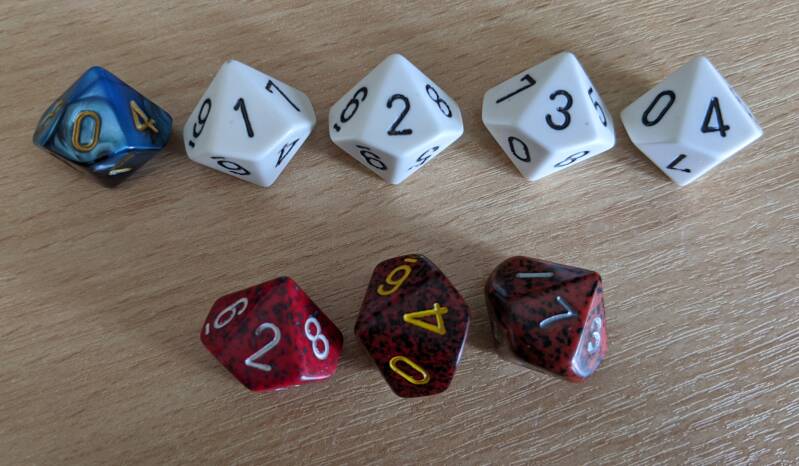
The strength of this augmentation is scored from 1-4. Your rank in the augmented virtue determines the number of additional dice you can roll for actions that use that virtue. Ideally, use a third colour for your augmented virtue dice.
Augmented virtue dice are wildcards that you can use to substitute in for any other dice on the roll - either swapping them in to your crib or replacing your virtue dice. As such they make your dice roll a lot better, and provide flexibility as to which special effects you can trigger from your crib.
Lets have a look at an example roll:

In this roll, if we ignore the red augmented virtue dice to begin with, we have a fifteen and a "one for his knob" in the crib (white dice), and a four on the blue virtue dice, which is a pretty low dice roll result of 7.
However, the 6 and 9 on the virtue dice allow us to improve the roll dramatically:
- If we swap in the 9 for the virtue dice, this puts the total up to 12 immediately.
- And if we swap in the six for the 3 we can add a pair to the result in addition, giving us a dice result of 14, double the original.
This is just one way of looking at this roll. It is the way that gives you the highest overall result, but by swapping the 9 on the virtue dice for the 3 in the crib and replacing the virtue dice with the 6 instead, we get two fifteens instead of a fifteen and a pair.
The total of the roll is lower, only 11, but in a situation where that is enough for success, the fifteens will likely give you better special triggers than a pair and a fifteen.
For example, if this was during a Wild Attack, a special sort of attack that allows you to score extra damage for each fifteen in your crib, you might prefer to take the lower roll, provided it was high enough to beat the target's passive defence and hit them.
Picking up the system
I will admit that this dice mechanic is perhaps the thing that most stands out about Newtonium Engine and may, at first glance, put people off as being overly complex. But as I said at the start, playtest has proven that this is not as complex as you would expect from a first read through, and further it adds both character and flavour to the dice rolls you make, and (when using augmented virtue dice, especially) provides interesting decision points and choices that will only enhance your enjoyment of the game.


Add comment
Comments